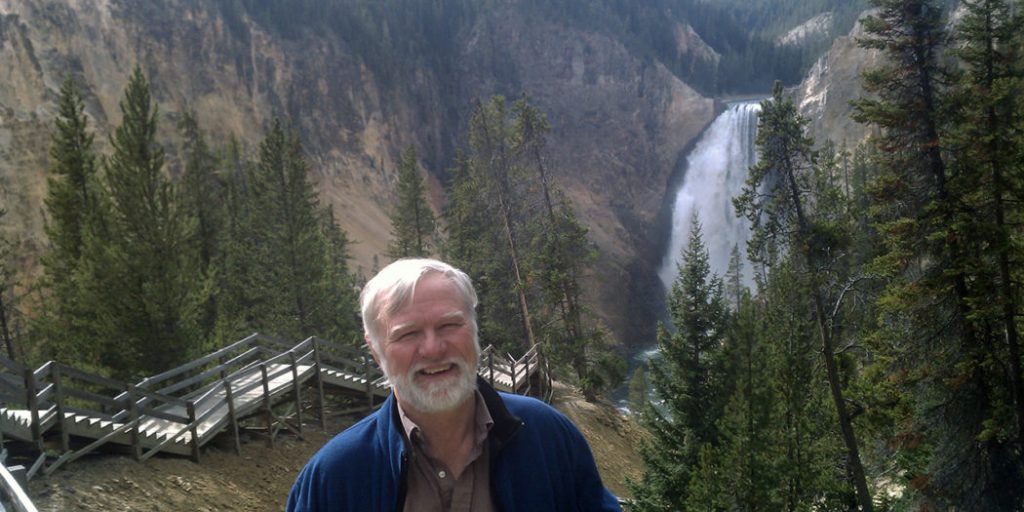
To listen to this reflection as a podcast, click here.
Yellowstone National Park is one of the most spectacular places on earth.
Larger than the combined acreage of Delaware and Rhode Island, the world’s first protected wilderness area boasts more than half of our planet’s geysers and hot springs, a large alpine lake, bountiful wildlife, its very own “grand canyon,” and the distinction of sitting atop an active super-volcano.
It also happens to be one of the most dangerous tourist destinations on earth.
Lee Whittlesey (shown above), who retired last May after nearly 50 years as a Yellowstone park ranger and historian, has documented more than 350 deaths (aside from car and snowmobile accidents) that have taken place within the park’s boundaries over the past century and a half. His book Death in Yellowstone: Accidents and Foolhardiness in the First National Park launched a whole new genre of page-turners about things that can go wrong in America’s wilderness areas.
The book is both harrowing and very hard to put down.
Yellowstone visitors have been scalded to death in boiling hot springs, eaten alive by grizzly bears, poisoned by innocent-looking plants, struck by lightning, gored by bison, crushed by falling rocks, buried in avalanches, and killed by 500-foot falls while trying to take selfies. Aside from that, a day at Yellowstone is just a walk in the park.
Whittlesey explains, “It’s not a sanitized city park. People think it’s like Disneyland and safe. But we have animals here that can eat you. People need to understand that.”
Most disasters can be avoided, of course, if people simply pay attention to the safety brochures they receive at the gate. Stay on the trails. Don’t feed the bears. Don’t leave the boardwalks in the geyser basins. Don’t go past the sign at the edge of the canyon that says don’t go past this sign.
Whittlesey recounts stories of people who simply can’t resist looking down the blowhole of Old Faithful, or who put their children atop a bison so they can take a really cute picture. One tourist told him that the animal trainer wasn’t doing a particularly good job, since a number of the animals still seemed to be wild and untamed.
That would be because they are, in fact, wild and untamed.
From time to time there are earnest calls to ramp up Yellowstone’s warnings. Rangers, it is urged, should build fences around every hot spring and put up signs that say, “This is exceedingly dangerous.”
But there are over 10,000 hot springs within the park. All those fences and signs would virtually eliminate the experience of wilderness – the inspiring, soul-restoring reason that brings most people to Yellowstone in the first place. Danger is an inherent part of the adventure.
Whittlesey describes the park as “nature in your face.” Yellowstone must be experienced on its own terms, not according to the personal whims and expectations of its many visitors.
The same thing is true with God.
All too many churchgoers go through life as if God is a safe, domesticated, stained-glass heavenly therapist who is “here for us.” We certainly don’t expect to be told that we’re supposed to encounter God on his terms.
Sometimes it takes someone like atheist author and social activist Barbara Ehrenreich to awaken our senses.
A few years ago she surprised her fans by writing a book with the provocative title Living With a Wild God. Ehrenreich recalls something that happened when she was 17 years old while walking alone on an empty street just before dawn.
“I found whatever I had been looking for… There were no visions, no prophetic voices or visits by totemic animals, just this blazing everywhere. It poured into me and I poured out into it… It was a furious encounter with a living substance… ‘Ecstasy’ would be the word for this, but only if you acknowledge [that it] does not occupy the same spectrum as happiness or euphoria, that it…can resemble an outbreak of violence.”
Furious encounter. Ecstasy. An outbreak of violence.
Does that sound like your last visit to a place of worship?
Ehrenreich still describes herself as an atheist. But if there really is Something or Someone out there, Ehrenreich believes she knows from personal experience that that Being is wild.
It’s worth noting that the Bible thinks God is wild, too. He speaks to a trembling Job out of darkness and storm (Job 38-40), shatters Isaiah with a vision of his utter holiness (Isaiah 6), and brings Moses to his knees in fear and awe (Exodus 3-6).
In C.S. Lewis’ Chronicles of Narnia, an enormous lion named Aslan represents Christ. The Narnians – whether they love Aslan or fear him – quickly learn that “he is not a tame lion.”
The God who is really there, likewise, will not be kept in a box. Nor can he be taken out on a leash. Religious programs will never keep him at bay. He’s not our Personal Assistant – someone we keep on retainer in case we need some help or advice later today.
It may be alarming to discover that God turns out to be wild and untamed.
But it’s even more exhilarating to learn from experience that when it comes to providing security, he also happens to be the original Old Faithful.
